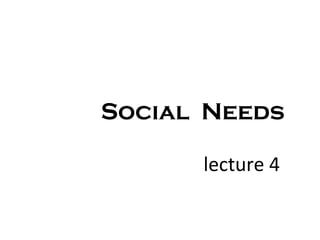
Lecture4 reeves soc_need
- 1. Social Needs lecture 4
- 2. Acquired Needs: Quasi-needs
- 3. ACQUIRED NEEDS: Social Needs
- 4. Primary Need-Activating Incentive Table 7.2 Incentive That Activates Each Social Need’s Emotional and Behavior Potential
- 5. Achievement
- 6. Origins of the Need for Achievement
- 7. Atkinson’s Model Tendency to Approach Tendency to Avoid Success (Ts) Failure (Taf) Ta = (Ms × Ps × Is) – (Maf × Pf × If ) • Maf : Motive to Avoid Failure • Ms: Motive to Success • Pf : Perceived Probability of • Ps : Perceived Probability Failure (1- Ps) of Success • If : Negative Incentive • Is : Incentive Value of value Success for Failure (1- Is)
- 8. Dynamics-of-Action Model Streams of Behavior for People High and Low in Ms and Maf 1. Latency to begin an achievement depends on motive strength. (Ms vs. Maf) 2. Persistence on an achievement task depends on motive strength. (Ms vs. Maf) 3. Switching to a nonachievement task occurs with rising consumption.
- 9. Conditions That Involve & Satisfy the Need for Achievement
- 11. Benefits of Adopting Mastery Goals Preference for a Challenging Task Work One can Learn From Harder Use Conceptually Based Learning Strategies Persist Longer doption of a Experience Greater astery Goal Intrinsic than Extrinsic Motivation More Likely to Ask Perform for Information & Help Better Performance Goal) (rather than a
- 12. Achievement Goals in the Classroom (Ames & Archer, 1988) Manifestations of Mastery and Performance Goals in the Classroom Context
- 13. Integrating Classical & Contemporary Approaches to Achievement Motivation
- 14. Antecedents & Consequences of the Three Achievement Goals (Elliot & Church, 1997) .22 Achievement .31 motivation Mastery goal .26 Intrinsic motivation -.34 .21 Performance- .36 Competence expectancy approach goal -.14 -.26 Graded .41 performance .45 Performance- -.34 Fear of failure avoidance goal
- 15. Avoidance Motivation & Well-Being
- 16. Implicit Theories Implicit Theories vs. Adoption of Performance Achievement Mastery Goals Goals Goals Utility of effort: High effort signals Meaning of Challenging tasks LOW ability. Effort require high effort.
- 17. AFFILIATION AND INTIMACY Profile of High Intimacy Motivation
- 18. Conditions That Involve & Satisfy the Affiliation and Intimacy Needs Need-Involving Condition Need-Satisfying Condition
- 19. POWER
- 20. Leadership Motive Pattern A special variant of the need for power is the leadership motive pattern.
- 21. End of Chapter 7
